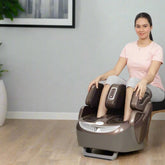Lumbar support belts are commonly used by individuals experiencing lower back pain or those who engage in heavy lifting during work. While these belts can offer significant support and help prevent injury, it's crucial to understand their potential side effects. In this comprehensive guide, we will explore both the benefits and the downsides of using lumbar support belts, ensuring you make an informed decision about your spinal health.
What are Lumbar Support Belts?

Lumbar support belts, also known as back braces, are devices designed to support the lower back. They are often recommended for people with back pain, those recovering from surgery, or workers performing strenuous activities. By stabilizing the lumbar region, these belts can help alleviate pain and prevent further injury.
Potential Side Effects of Lumbar Support Belts
While lumbar support belts can be beneficial, they are not devoid of potential drawbacks. It is important to be aware of these side effects to avoid adverse impacts on your health.
1. Muscle Weakness and Dependency
Continuous use of lumbar support belts may lead to muscle weakness in the abdomen and lower back. Over-reliance on the belt can cause the core muscles to weaken over time, as they become dependent on the artificial support, potentially leading to worse posture and increased risk of injury when the belt is not worn.
2. Skin Irritation and Discomfort
Wearing a lumbar support belt for extended periods can cause skin irritation or discomfort. Poorly fitted belts can create pressure points, leading to skin abrasions or even bruising, particularly if the belt is too tight.
3. Digestive Issues
Tight lumbar support belts can compress the abdominal region, potentially interfering with digestion. Users may experience discomfort such as bloating, indigestion, or constipation, particularly after meals.
4. Blood Circulation Problems
Excessive tightness of a lumbar support belt can also impede blood flow around the abdominal and lower back area. Reduced blood circulation can lead to numbness and tingling sensations in the legs.
Best Practices for Using Lumbar Support Belts
To minimize the risk of side effects while using a lumbar support belt, consider the following guidelines:
- Proper Fit: Ensure the belt fits well. It should support the lower back without being too tight.
- Limit Duration: Use the belt only when necessary, such as during activities that strain the back.
- Strengthen Muscles: Engage in exercises that strengthen the core and lower back muscles to reduce dependency on the belt.
- Consult Healthcare Providers: Always consult with a healthcare provider before starting or continuing the use of a lumbar support belt, especially if you experience ongoing pain or discomfort.
FAQ's
1. What are the common side effects of using a lumbar support belt?
Common side effects include muscle weakness, skin irritation, digestive issues, and impaired circulation.
2. Can wearing a lumbar support belt weaken back muscles?
Yes, prolonged use of a lumbar support belt can lead to muscle weakening in the back and abdomen due to reduced natural support and engagement.
3. How tight should a lumbar support belt be?
A lumbar support belt should be snug enough to offer support without causing discomfort or restricting blood flow and digestion.
4. Is it safe to wear a lumbar support belt all day?
It is not advisable to wear a lumbar support belt throughout the day. Limit its use to periods when extra support is necessary, such as during heavy lifting or prolonged standing.










